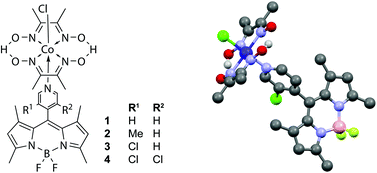Synthesis, characterization and structural investigation of novel meso-pyridyl BODIPY–cobaloxime complexes†
Abstract
We report the synthesis of four boron–dipyrromethene (BODIPY) sensitized cobaloxime complexes as structural models of light-driven

* Corresponding authors
a
North Carolina State University, 2620 Yarborough Drive, Campus Box 8204, Raleigh, NC 27695-8204, USA
E-mail:
wwweare@ncsu.edu
Fax: +1 919515 8920
Tel: +1 919515 1746
We report the synthesis of four boron–dipyrromethene (BODIPY) sensitized cobaloxime complexes as structural models of light-driven

 Please wait while we load your content...
Something went wrong. Try again?
Please wait while we load your content...
Something went wrong. Try again?
J. Bartelmess, W. W. Weare and R. D. Sommer, Dalton Trans., 2013, 42, 14883 DOI: 10.1039/C3DT51849C
To request permission to reproduce material from this article, please go to the Copyright Clearance Center request page.
If you are an author contributing to an RSC publication, you do not need to request permission provided correct acknowledgement is given.
If you are the author of this article, you do not need to request permission to reproduce figures and diagrams provided correct acknowledgement is given. If you want to reproduce the whole article in a third-party publication (excluding your thesis/dissertation for which permission is not required) please go to the Copyright Clearance Center request page.
Read more about how to correctly acknowledge RSC content.
 Fetching data from CrossRef.
Fetching data from CrossRef.
This may take some time to load.
Loading related content
